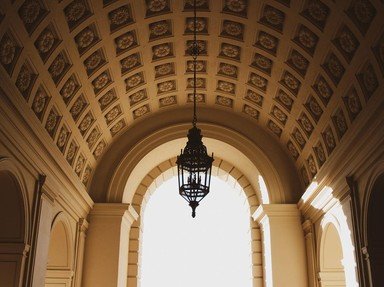Quiz Answer Key and Fun Facts
1. In 1969, NASA put a man on the moon, but just before that giant leap, first-stage engines were used for lift-off. Those engines have been on the bottom of the Atlantic Ocean until March 2013, when they were recovered. Which spacecraft were these engines from?
2. Queen Anne's Revenge sat on the floor of an inlet of the Atlantic Ocean from 1718 to 2013. Over 30 cannons and thousands of artifacts have since been recovered, but what was Queen Anne's Revenge?
3. In 1900, divers off the coast of Greece found an old shipwreck and recovered all kinds of artifacts, including what looked like a 16th century mechanism - possibly an early mechanical computer. But that's not that astonishing part. When historians dated it, how old did they think the mechanism was?
4. In 1857, the SS Central America was caught in a hurricane and sank off the coast of the Carolinas. This was an important ship whose sinking contributed to the Panic of 1857 and the first worldwide economic crisis. In 1988, the ship was located and its contents recovered. What was found that the ship was carrying?
5. In 2012, single cell microbes were found alive, barely alive, in the Pacific Ocean. The significance to the finding was that these microbes were named the oldest living organisms. Which era are these microbes from?
6. The British ship SS Gairsoppa was torpedoed by the Germans during World War II and sank in the Atlantic Ocean off the coast of Ireland in 1941. The wreck was discovered in 2011 with what valuable property recovered?
7. In 1545, a ship sunk in battle. In 1982, the ship was recovered from the bottom of the strait separating mainland England from the Isle of Wight. The recovery included the hull of the ship, 26,000 artifacts and remains of half of the crew members. Which ship was this?
8. In 2010, a team of archaeologists discovered an old shipwreck off the shore of Salcombe in Devon, England. They recovered copper and tin ingots, weapons and jewelry that were made in what is now France. This discovery suggests that a trade network existed between Britain and Europe in the Bronze Age. What time period was this shipwreck from?
9. Sitting on the bottom of the Mediterranean Sea for more than 1,200 years, Thonis-Heracleion was recovered by European underwater archaeologists in 2000. A wide range of artifacts have been preserved that can tell us so much about this bygone era. But what is Thonis-Heracleion that was once on the sea floor and is now above ground?
10. In approximately 830 AD, an Arabian ship was sailing from China to Africa but sank. In 1998, fishermen discovered this shipwreck in the Gelasa Strait off the shores of Belitung, Indonesia. Not only was this the first discovered Arabian ship, but its cargo was an important and valuable find. What was on the ship?
Source: Author
napierslogs
This quiz was reviewed by FunTrivia editor
bloomsby before going online.
Any errors found in FunTrivia content are routinely corrected through our feedback system.
